An international group of researchers investigated the openness of forensic science research by taking a closer look at 30 forensic science journals. What they found is concerning.
In a new paper published in the Journal of Law and the Biosciences, Dr. Jason Chin, law and psychology lecturer at Sydney Law School and his colleagues discovered that much of forensic science research operates behind closed doors, making verification of published results nearly impossible.
Researchers found that many journals do not require authors to post their data online for others to scrutinize. Despite safeguards of research protocols such as validation testing and blinding, individual biases and more can still taint research findings.
Yet the prosecution often relies on these results and often the accused doesn’t have an equal opportunity to review the information. Without open access, criminal verdicts are vulnerable to distortion. For example, The Innocence Project found that nearly half of wrongful convictions in the US overturned by DNA evidence are based on invalidated or improper forensic science.
Chin states, “Openness is one fix for this. Removing journal paywalls, for example, can prompt more widespread verification of results.”
CSAFE reiterates Chin’s suggestions. “Open source data for the forensic community is important because it allows solutions that use the data to be benchmarked by not only the team providing the solution but other community members. This enables the community to benefit from thorough testing, to find weaknesses and strengths of the tools and also of the data itself,” CSAFE researcher Jennifer Newman said.
Working to counteract the roadblocks to open-source data in forensic science, CSAFE released a Data Portal, providing public access to forensic science datasets for anyone to implement in their analysis techniques. Read more in our recent news story, and learn about newly proposed U.S. legislation to increase transparency in forensic science.
Access the full paper by Dr. Chin: https://academic.oup.com/jlb/advance-





